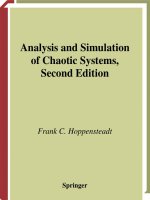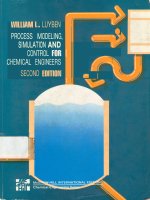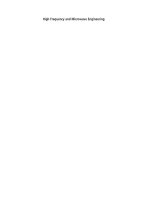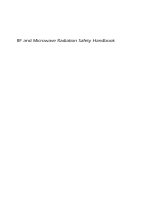kitchen, r. (2001). rf and microwave radiation safety handbook (2nd ed.)
Bạn đang xem bản rút gọn của tài liệu. Xem và tải ngay bản đầy đủ của tài liệu tại đây (4.91 MB, 442 trang )
RF and Microwave Radiation Safety Handbook
RF and Microwave Radiation
Safety Handbook
RONALD KITCHEN
OXFORD AUCKLAND BOSTON JOHANNESBURG MELBOURNE NEW DELHI
Newnes
An imprint of Butterworth-Heinemann
Linacre House, Jordan Hill, Oxford OX2 8DP
225 Wildwood Avenue, Woburn, MA 01801-2041
A division of Reed Educational and Professional Publishing Ltd
A member of the Reed Elsevier group
First published 1993 by Butterworth-Heinemann as
RF Radiation Safety Handbook
Reprinted 1995, 2000
Second edition 2001
© Ronald Kitchen 1993, 2001
All rights reserved. No part of this publication
may be reproduced in any material form (including
photocopying or storing in any medium by electronic
means and whether or not transiently or incidentally
to some other use of this publication) without the
written permission of the copyright holder except in
accordance with the provisions of the Copyright,
Designs and Patents Act 1988 or under the terms of a
licence issued by the Copyright Licensing Agency Ltd,
90 Tottenham Court Road, London, England W1P 0LP.
Applications for the copyright holder’s written permission
to reproduce any part of this publication should be addressed
to the publishers
British Library Cataloguing in Publication Data
A catalogue record for this book is available from the British Library
ISBN 0 7506 43552
Composition by Genesis Typesetting, Laser Quay, Rochester, Kent
Printed and bound in Great Britain
v
Contents
Preface vii
1 Introduction to RF and microwave radiation 1
2 Sources of radio frequency radiation 21
3 Effects of radio frequency radiation 47
Part 1 The exposure of human beings to RF radiation 47
Part 2 Incidents and accidents relating to RF exposure 78
4 The development of standards for human safety 86
Part 1 Basic concepts of RF safety standards and guides for
human exposure 86
Part 2 Typical current safety standards for human exposure 95
Part 3 Safety calculations for structures involving flammable
vapours 119
5 The calculation of RF field quantities 129
Part 1 Microwave antenna calculations and safety with
moving microwave beams 129
Part 2 Other antenna system calculations 158
Part 3 Simultaneous irradiations and peak pulse power limits 168
6 Mobile communications systems 172
7 RF radiation measuring instruments and methods 293
8 X-rays and X-ray measuring instruments 244
9 Planning surveys and measurements 278
vi
Contents
10 Conducting radiation measurements and surveys 317
Part 1 Leakage surveys 317
Part 2 Exposure measurements 332
11 Designing to reduce radiation hazards 366
12 Radio frequency radiation safety management and training 392
Appendix 1 Useful data and relationships 413
Appendix 2 Technical and organisation abbreviations 416
Appendix 3 Information sources including the Internet 419
References 422
Index 429
vii
Preface
Since the previous volume on this topic was written about eight years ago
many things have changed, not least the various safety standards and these
interact with most aspects of the subject. I have endeavoured to implement
some of the suggestions made to me for this revision without seriously
increasing the book size. To some extent the updating of this sort of book is
like being on an endless belt since new material appears almost daily and
there is the need to draw the line at some point.
As the book is addressed to people responsible for or concerned with
safety, it cannot be assumed that all those involved are radio engineers. Often
people from other disciplines such as mechanical engineering, chemistry and
medicine, may be involved. Consequently some attempt has been made to
explain things which the radio engineer might consider everyday matters.
The general introduction to the book covers some of these aspects as
previously. It is followed by updated pictorial examples of the sort of RF
radiation sources likely to be met in RF radiation work, including RF
process machines.
Chapter 3 on RF radiation effects has been revised and a new part
introduced dealing with actual RF incidents and accidents. I am indebted for
part of this to Dr Ren´e de Seze and to various colleagues. The chapter on
standards (Chapter 4) has been completely updated and current standards
compared. The FCC limits tables have been added as have the FCC and UK
tables of assessment levels applicable to radio amateurs.
A chapter on mobile radio has been added (Chapter 6) and other chapters
revised appropriately. Chapters 7 and 8 dealing with measuring instruments
have been re-written with the new generation of instruments in mind
although there is still some coverage of analogue RF radiation instruments
since many are in use around the world. Every chapter now has an
explanatory heading describing the contents.
I am indebted to the various organisations for permission to publish parts
of their standards and to BSI for permission to use material from their
viii
Preface
standards. The European Union is still in the course of doing something
about occupational RF radiation safety. The expectation is that the
ICNIRP98 limits will be adopted for occupational purposes. The EC
Machines Directive also touches the subject of radiation and is mentioned in
this revision.
The best development since the last book was written is the Internet and
the availability of a lot of material which can be downloaded from various
sites. This means that readers of this book can easily update themselves when
something new arises. I have given some Internet data in Appendix 3 and
though website arrangements do change in structure from time to time, it is
usually easy to use the site search facilities to unearth the desired material.
In all this I am indebted to many people for help with finding reports,
pictures and other material, reading drafts, etc. They include: Robert
Johnson of Narda for help with technical documents; Mike Spalding, a
colleague from our Marconi days who apart from reading drafts has taken
over the task of running the RF radiation safety courses; Stephen Sharples,
NATS; Eric Randall, Cable and Wireless Communications; Chris Jacob, BT;
John Coleman, Consultant; Steve Phillipo, Bill Hartley, NTL; Peter
Condron, Crown Castle Int.; David Wood, Stuart Allen and Phillip
Chadwick, NRPB, for help in finding information, and all those who
provided pictures of their instruments and equipment.
I am sure that I have missed people in the above list but if so, they can rest
assured that their help was appreciated. Needless to say these people and
their organisations are not responsible for any use I have made of
information or any opinions expressed.
Lastly, and by no means least, I am grateful for the love and support of my
wife, Gene, both in reading the whole manuscript more than once despite
the unfamiliar content, putting up with my long periods spent at the
computer and being philosophical about the idea that I retired ten years
ago.
As this book is used as the course book on the training course which I set
up at TUV Fareham, the book is dedicated to the Royal Air Force and others
attending the course.
Ron Kitchen
Chelmsford
The Birthplace of Broadcasting
1
1
Introduction to RF and
microwave radiation
This chapter gives an outline of the essential aspects of transmission
and the nature of electromagnetic waves particularly for those from
other disciplines who may otherwise find the electronic content
unfamiliar. It includes explanations of the terms relevant to this form
of non-ionising radiation.
Radio frequency (RF) radiation
The previous book on this subject was entitled RF Radiation Safety
Handbook, the term ‘RF’ covering all frequencies used for communications,
radar, satellites, etc., up to the nominal ceiling of 300 GHz. However, it was
suggested that some people regard ‘RF’ as applying only to the lower part of
this spectrum. Consequently the word ‘microwave’ has been added in this
revision, although it is redundant in the context of the book. It would be
tedious to use both terms throughout the book so ‘RF’ is used to include
‘microwaves’ here as is understood by radio engineers. The term microwave
is only specifically used when the topic involves something to which the
term normally attaches, e.g. microwave oven, microwave antenna, etc.
The subject of RF radiation is still regarded as mysterious and something
of a black art. This is no doubt due to the fact that it cannot be seen or
touched. There was also an element of magic in some of the very early
experimental work, particularly that of Tesla, who seems to have mixed
science and showmanship.
Perhaps because RF is unseen, it has also become confused with ionising
radiation in the minds of many people. It is essential to distinguish the
difference between the two since, with our present state of knowledge, the
consequences of exposure to them can confidently be stated as being very
different.
2
RF and Microwave Radiation Safety Handbook
Although we cannot see radio waves, most people will, at school or
college, have done the classical experiments with magnetic fields and iron
filings to demonstrate the patterns of the fields and used an electroscope to
demonstrate the presence of electrostatic charge and the force which causes
the gold leaf to move.
From these early and rudimentary experiments with static fields it should
at least be possible to conceive that such fields are not magical and are very
common in any electrical environment.
History of radio transmission
Radio transmission is, relatively speaking, a very new technology which had
its beginnings in the theoretical work of Maxwell in the nineteenth century
and the experimental work of Hertz, the German physicist, in the last two
decades of the nineteenth century. Many others also made contributions,
including the development of devices which could detect the presence of
radio waves. Whilst the question of who first transmitted radio signals is not
without controversy, the subsequent practical development of radio
communications systems is attributed to Guglielmo Marconi who was born
in Italy in 1874.
His first British patent was taken out in 1896 and covered the use of a
spark transmitter. There are many accounts written of the experimental
work carried out at various locations on land and on ships during the
course of which the range of such equipment was very much increased. By
1921, the thermionic transmitter tube became available and made it
possible to design transmitters to operate on a range of frequencies. The
power output available increased with the development of electronic tubes
which could, increasingly, handle higher powers with the aid of air or
liquid cooling systems.
Over the years, and stimulated by the needs of the First and Second World
Wars, radio transmission has become an established technology which is
taken for granted and which, among other things, provides for the
broadcasting to our homes of entertainment, news and information of every
kind in both the radio and television spheres. The most recent development,
resulting in the domestic satellite dish antenna, brings the quasi-optical
nature of microwaves to the notice of the consumer.
The use of semiconductor devices (transistors) has become common-
place and as a result the mass and volume of electronic products for a
given function is much less than that of their earlier counterparts which
used electronic tubes. However, in the high power transmitter field
electronic tubes are still the mainstay of transmitters. These use very high
voltages, depending on power output. 40 kV or more is not unusual for
very high power equipments. High power systems such as MF and HF
Introduction to RF and microwave radiation
3
broadcasting systems need considerable provision for cooling the vacuum
tubes used and in some cases the resulting heat is transferred to the station
heating system!
Semiconductor devices are being used in transmitters of more modest
power and also in spaced array radar equipments and do not need high
voltages. Semiconductor devices do also have a considerable role in
transmitter drives, audio circuits and in control systems. In the latter
application, sophisticated logical control circuits are easy to achieve and
occupy the smaller volumes attributable to the small size of transistors and
integrated circuits.
With the vast increase of terrestrial and satellite broadcasting and
communications, and the enormous number of mobile phones now in use,
homes, work and recreational places are irradiated by a vast number of
electromagnetic signals. Many are intended to operate receiving equipment,
most of which are at very low levels because the high sensitivity of receivers
does not necessitate large signals. Mobile phones do however communicate
both ways and thus incorporate transmitters and receivers. As usage
increases there is pressure for the use of more frequencies such that
governments now sell licences to use parts of the RF spectrum.
Some radiation is unintentional, resulting from the leakage of energy from
devices which have no radiation function, for example, due to inadequate
shielding, unblocked apertures in metal cases, and similar shortcomings.
Apart from any effects of leakage on people, it also causes interference with
other equipment. It is not surprising that the presence of so much
electromagnetic interference has caused people to question whether they can
be harmed by it.
The word ‘wireless’ largely passed out of use many years ago. Radio is
now the more general term in use, though strangely enough in domestic use
it tends not to have the same wide use, mainly being interpreted as meaning
sound broadcasting with the term ‘television’ or ‘TV’ to describe television
picture and sound broadcasting. There are many words used to describe
forms of radio system including satellite communications, radar, microwave
links, mobile telephones, etc.
Despite the profusion of terms in use to describe the transmission of
intelligence by electromagnetic waves, the nature of these waves is basically
the same, the variable being the way in which the intelligence (signal) is
added. It is therefore convenient to refer to these electromagnetic waves as
‘radio waves’ and the frequencies of the waves as ‘radio frequencies’.
The nature of radio waves
Most readers will be familiar with the fact that an alternating current or
voltage which is undistorted has an amplitude which varies with time and
4
RF and Microwave Radiation Safety Handbook
reverses direction at each 180°, one cycle taking 360°. This pictorial
representation of a current or voltage is referred to generally as a waveform
and the description above is that of a sine wave. Waveforms may have other
shapes such as square waves, ramps, etc., as will become apparent later.
A sinewave is illustrated in Figure 1.1 and is shown with the ‘Y’ axis
denoted arbitrarily in amplitude (A). The term amplitude is used to refer to
the magnitude of the voltage or current.
The instantaneous amplitude (amplitude at a specified point in time) can
be read from such a diagram and will be found to follow a sine curve, i.e. it
is equal to the maximum amplitude (A) multiplied by the sine of the
corresponding angle.
Hence at 0° and 180° the instantaneous amplitude is zero. Similarly at 90°
and 270° the instantaneous amplitude is at the maximum A but since the sine
of 270° is negative the polarity and hence the direction of current flow has
reversed. This diagram is basically applicable to any simple AC waveform.
One of the factors which distinguishes such waveforms is the time duration
of one complete cycle (T) in Figure 1.2 and another the frequency (f).
Frequency is simply the number of cycles per unit time and the
international convention is ‘per second’. The unit is the hertz (Hz) named
after the German physicist, one hertz corresponding to one cycle per second.
It follows that the time of one cycle in seconds is given by the reciprocal of
the frequency in hertz.
Figure 1.1 Sine wave illustration
Introduction to RF and microwave radiation
5
The AC mains supply frequency (50 or 60 Hz) is referred to as a low
frequency whereas the frequencies used for radio transmission are much
higher frequencies. The time T for the duration of a cycle at, for example,
50 Hz is 1/50s = 20 ms (twenty thousandths of a second) whereas the time
for higher frequencies is much shorter as shown in the examples below:
T (secs) = 1/f(Hz)
Examples:
1 f = 100 kHz T = 10 s (10
–5
s).
2 f=1MHz T=1s (10
–6
s).
3 f = 1000 MHz T = 1ns (10
–9
s).
For those unfamiliar with these SI prefixes (, n, etc.), see Table 1.1 which
lists those actually used in everyday work.
Figure 1.2 Sine wave frequency and time relationship
Table 1.1 The most commonly used
International System (SI) prefixes
Symbol Name Factor
k kilo 10
3
M mega 10
6
G giga 10
9
T tera 10
12
m milli 10
–3
micro 10
–6
n nano 10
–9
p pico 10
–12
6
RF and Microwave Radiation Safety Handbook
If the existence of two identical waveforms as shown in Figure 1.3, is
considered, it is possible for these to be displaced along the time axis so that
whilst they are identical in form, the starting points of the cycles may not be
identical, i.e. there is a phase difference between the two waveforms.
This may be expressed in angular terms, e.g. 90° phase difference. If two
such identical waveforms are exactly in phase and are added, the amplitude
of the resultant at any point will be twice that of either waveform alone.
Conversely, if the two waveforms are 180° out of phase the sum will be
zero. This becomes relevant when considering radiation surveys and it is
necessary to consider the additive possibilities of radio waves reflected from
the ground and from metal masses. Obviously additions increase any
potential hazards whereas cancellations are less significant in this context
since the safety measurement activity is essentially concerned with the
highest levels present.
Readers will also be familiar with the idea that a current flowing in a
conductor gives rise to a magnetic field around it. When such a current is
varying, it gives rise to a similarly changing electric field. Similarly a
changing electric field will give rise to a magnetic field. Unchanging fields of
either kind will not result in the production of the other kind of field. With
changing fields the magnetic field and electric field are thus inextricably
Figure 1.3 Phase difference between two waveforms
Introduction to RF and microwave radiation
7
linked. Hence alternating currents and voltages do, by definition, involve
time-varying fields.
It is easy to imagine that from any source of such fields some energy may
be unintentionally released (transmitted) into free space, causing interference
with receivers or other equipment, without necessarily understanding the
phenomenon. This is because such ‘interference’ has been experienced by
most people in their everyday lives. Perhaps the most common example is
the motor car ignition system which can also prove to be a rudimentary
example of the spark transmitter!
In the case of radio transmitters, however, the whole intention is to
transmit RF energy into free space and the antenna used to do so is
specifically designed to achieve this objective. If we consider the fre-
quencies discussed above, the very low frequencies, e.g. mains power
frequencies, do not give rise to any significant amount of radiation.
However, as we increase the frequency then it becomes increasingly
possible to radiate electromagnetic waves, given a suitable antenna to act
as an efficient ‘launcher’.
The electric and magnetic field quantities mentioned above perhaps need
a little more elaboration. The electric (E) field at any point is defined as the
force acting on a unit positive charge at that point. The magnitude of the
electric field is expressed in volt per metre (Vm
–1
).
The magnetic field at a point is also a force and is defined as the force
which would act on an isolated north pole at that point. The classic
demonstration of this is that the earth’s magnetic field exerts a force on a
compass needle, to the great blessing of navigators. The ampere is defined on
the basis of the magnetic force exerted when a current flows in a conductor
and magnetic field strength is measured in ampere per metre (Am
–1
).
Being forces, both quantities are vector quantities having magnitude and
direction. The normal Ohm’s law equations for power when the voltage
and current are in phase (plane wave conditions) can be used in an
analogous way and with the same phase qualification to calculate power
density.
Plane wave conditions involve the concept of ‘free space impedance’
which is given by the expression:
Z
0
(⍀)=√(
0
/
0
)
Where
0
is the permeability of free space and
0
is the permittivity of free
space
Hence Z
0
= √(4 × 10
–7
/8.854 19 × 10
–12
) = 376.7 ⍀ (taken as being
377 ⍀).
For plane wave conditions, Z
0
= ͦEͦ/ͦHͦ where E and H are field values in
Vm
–1
and Am
–1
respectively. Hence, under the same conditions, S (Wm
–2
) =
E
2
/Z
0
= H
2
× Z
0
where S is the power flux density in Wm
–2
.
8
RF and Microwave Radiation Safety Handbook
In the USA the most common unit used for S is mWcm
–2
and being the
larger unit, is numerically one tenth of the quantity expressed in Wm
–2
, i.e.
1 mWcm
–2
=10Wm
–2
Electromagnetic waves propagated in free space have the electric and
magnetic fields perpendicular to each other and to the direction of
propagation, as represented in Figure 1.4 and are known as transverse
electromagnetic waves (TEM waves).
The basic nature of an electromagnetic wave can be physically illustrated
by holding two pencils with their unsharpened ends touching and the two
pencils being mutually at right angles to each other and held so that one is
parallel to the ground and one pointing vertically to represent the planes
illustrated in Figure 1.4. If now a third pencil is added, mutually at right
angles to the other two, it will indicate the direction of propagation as in the
figure. The vertical pencil point represents the electric field (vertically
polarised wave) and the second pencil the magnetic field.
The plane of polarisation of a wave is, by convention, that of the electric
field, i.e. the polarisation in Figure 1.4 is vertical. This convention has the
advantage that for vertical polarisation the antenna will also be vertical (e.g. a
simple rod antenna) and this convention is followed in this book. If the
diagram is rotated until the electric field is horizontal then the wave
polarisation is horizontal. Apart from this ‘linear polarisation’, other forms
such as circular or elliptical polarisation are also used for specific purposes.
There is another approach to RF radiation whereby the concept of
particles (photons) is used to describe the radiated signal. However, for the
purposes of this work, the wave concept seems to serve the purpose best and
is generally so used.
Figure 1.4 Representation of a plane wave
Introduction to RF and microwave radiation
9
Frequency and wavelength
Two related characteristics of electromagnetic waves are used as a method of
referencing the waves. They are the frequency (already discussed above) and
the wavelength. The latter is denoted by the symbol lambda (). The
relationship between these two characteristics involves consideration of the
velocity of propagation of radio waves.
The velocity of propagation of all electromagnetic waves (c) is constant in
a given homogenous medium and in free space has a value of 2.997 925 ×
10
8
ms
–1
but the approximate figure of 3 × 10
8
metres per second is used in
practical calculations. This figure is also used for air but does not apply to
propagation in other media. The relationship between frequency and
wavelength is:
c=f
where the wavelength () is the physical length of one cycle of the
propagated wave, as shown in Figure 1.4.
For electromagnetic waves in free space, where f is in hertz (Hz):
(m)=3 × 10
8
/f
Examples:
1 f = 200 kHz = 1500 metres
2 f=10MHz = 30 metres
When f is in MHz, the division simplifies to: (m) = 300/f. This lends itself
to easy mental arithmetic! Wavelength is an important parameter in
considering antenna systems and propagation since it is a factor in
determining the physical dimensions of antennas.
Without going into antenna detail at this stage, some idea of the physical
comparison of wavelengths can be obtained from the examples of the length
dimension of a /4 (one quarter wavelength) antenna for a few frequencies
shown in Table 1.2. Practical antennas will be a little shorter than the
theoretical calculations of Table 1.2.
Radio waves can therefore be referred to either by the wavelength or the
frequency. Domestic receivers may have the scaling in either unit but
generally frequency is used, as it is in professional radio work. Wavelength
does need to be used when it is involved in determining the physical
dimensions of antennas and other devices.
In this book, the range of frequency considered is roughly from 10 kHz to
300 GHz. Table 1.3 illustrates the names for the various sub-divisions of the
radio spectrum. The term ‘microwave’, mentioned earlier, does not appear in
the listing although with the advent of microwave ovens it has become
10
RF and Microwave Radiation Safety Handbook
widely used and misused in the public domain. There is no generally agreed
definition but it is often used to apply to frequencies from several hundred
MHz upwards.
It should be noted that the term ‘radio frequency’ (RF) is used here across
the whole spectrum as a generic term and the term ‘microwaves’ merely
refers to a portion of the RF spectrum.
The abbreviated band identifiers in Table 1.3 from VLF to UHF are in
frequent use but the abbreviations SHF and EHF are less used, being now
increasingly swallowed up in the loose use of the term ‘microwaves’. In
addition there is a more specific classification system for bands in the upper
UHF onwards.
This is given in Table 1.4 on the basis of the IEEE listings. It has to be said
that different versions of these band classifications are in use across the
world and in textbooks so that reference to frequency is perhaps the only
safe way of avoiding ambiguities. The presentation of the different possible
classifications tends to confuse rather than enlighten.
Table 1.2 Nominal quarter wave antenna
length for a number of frequencies
Frequency
(MHz)
Length – one quarter
wavelength (m/cm)
0.1 750 m
175m
10 7.5 m
100 0.75 m (75 cm)
1 000 0.075 m (7.5 cm)
10 000 0.0075 m (0.75 cm)
Table 1.3 Frequency band designations
Frequency Band code Band description
300 Hz–3 kHz ELF Extra Low Frequency
3 kHz–30 kHz VLF Very Low Frequency
30 kHz–300 kHz LF Low Frequency
300 kHz–3 MHz MF Medium Frequency
3 MHz–30 MHz HF High Frequency
30 MHz–300 MHz VHF Very High Frequency
300 MHz–3 GHz UHF Ultra High Frequency
3 GHz to 30 GHz SHF Super High Frequency
30 GHz to 300 GHz EHF Extra High Frequency
Introduction to RF and microwave radiation
11
Conveying intelligence by radio waves
When a wave of a given frequency is radiated continuously, i.e. a
continuous series of sine waves, no intelligence is conveyed and the signal
is called a ‘carrier’. This mode of transmission is known as continuous
wave (CW). Nothing can be heard unless there is a local oscillator to ‘beat’
with the carrier and produce a note at the difference frequency. This is
referred to as heterodyning.
If the carrier is switched on and off in accordance with some kind of
code, e.g. morse code, then this intelligence can be interpreted. More
generally, for broadcasting the intelligence may be speech, music, and
television pictures. Other professional work includes voice and data
transmission by a variety of methods, radar transmitters transmit RF
signals in a series of pulses and so on.
The process of sending intelligence is referred to as the process of
modulation and the technical methods of doing so are wide ranging and
outside the scope of this book. It is however useful to illustrate the general
nature of amplitude modulation which has some significance when
carrying out radiation measurements, and also to illustrate the principle of
pulse transmission.
Figure 1.5 illustrates the waveform of a carrier and of the same carrier with
50% modulation applied in the form of a simple audio frequency sinewave.
It can be seen that the peak instantaneous amplitude of the 50% modulated
wave is 1.5 A against A for the carrier. Clearly the total power is greater
when the carrier is modulated and hence any field measurements made will
need to be related to the modulation state. For amplitude modulation, Figure
1.6 shows the relationship between sine wave amplitude modulation depth
versus transmitted RF power and RF current.
Figure 1.7 shows a pulse transmission where the carrier is transmitted for
time t
p
(the pulse duration) and with a pulse repetition rate of n Hz (pulses
per second). It is of course, not possible to show this to scale since there will
Table 1.4 Microwave band letters (IEEE)
Frequency – GHz Band letter
1–2L
2–4S
4–8C
8–12.5 X
12.5–18 Ku
18–26.5 K
26.5–40 Ka
12
RF and Microwave Radiation Safety Handbook
Figure 1.5 RF signal, amplitude modulated by a low frequency signal
Figure 1.6 Sine wave amplitude modulation depth versus RF power and RF
current
Introduction to RF and microwave radiation
13
be too many cycles of carrier in each pulse to actually illustrate them. For
example a radar working at 1 GHz and with 2s pulses will have 2000 cycles
of carrier in each pulse.
There are many other methods of modulation and transmission which can
be applied to radio equipment and which cannot be covered here but which
need to be known to those doing safety surveys.
Much power is wasted in amplitude modulation and various other forms
which reduce the waste are widely in use such as single sideband (the two
sidebands in AM contain identical intelligence) with a reduced carrier power,
double sideband where the two sidebands carry different intelligence and
again the carrier is reduced, etc.
Some of these are mentioned later in this book where they have some
significance. In particular the recent development of digital radio and
television will become widespread over the next few years.
Ionising and non-ionising radiations
Confusion between these two forms of radiation amongst the public has
been mentioned earlier. There is also a surprising amount of misunderstand-
ing amongst electronics and radio engineers about the distinction between
these two forms of radiation even amongst newly qualified graduate
engineers, so that RF radiation is sometimes considered to be the same as
ionising radiation.
Ionising radiation, by definition, is radiation capable of ejecting electrons
from atoms and molecules with the resultant production of harmful free
radicals. There is a minimum quantum energy below which this disruption
cannot take place. Since the human body is largely water, the water molecule
is used to define this minimum level.
Different reference sources give varying figures for this between 12 eV and
35 eV. The actual value does not matter for the purposes of this comparison.
12 eV corresponds to a wavelength of 1.03 × 10
–7
metres (103 nm) which can
be seen from Figure 1.8 lies just above the ultraviolet (UVc) spectrum. The
Figure 1.7 Pulse modulation
14
RF and Microwave Radiation Safety Handbook
highest RF frequency used in standards for RF safety is 300 GHz which
corresponds to a wavelength of 10
–3
metres and lies in the EHF band of the
radio frequency spectrum. If the calculation is done the other way round,
300 GHz corresponds to an energy of 0.00125eV (see Appendix 1) which,
from the foregoing, is too small by about four orders to cause ionisation.
However, in radio transmitters using very high supply voltages, ionising
radiation in the form of X-rays are produced and for this reason the subject
is covered in some detail in Chapter 8. It should be clear that this ionising
radiation is not inherent in the RF energy but rather that both forms of
radiation can co-exist inside equipment and the RF engineer or technician
needs to be aware of the hazards involved. It is also the case that ionising
radiation is, in most countries, subject to definitive legal provisions due to its
hazardous nature.
Explanation of terms used
In this section those terms and units which are most frequently used in
dealing with RF radiation are explained. The more formal definitions may be
found in reference books. Other more specialised terms are introduced in
the text as appropriate. Abbreviations are given in Appendix 2. Common
units and conversions are given in Appendix 1.
1 Transverse electromagnetic mode wave (TEM)
An electromagnetic wave in which the electric and magnetic fields are
both perpendicular to each other and to the direction of propagation (see
Figure 1.4).
2 Power
The rate of doing work in joules per second. The unit is the watt (W) which
corresponds to 1 Js
–1
. Sources of RF energy are rated in watts. Both the
kilowatt (kW) and the megawatt (MW) are common in radio work, the latter
typically for very high power equipment such as radar equipment.
Figure 1.8 Radiation wavelengths relative to 300 GHz (WHO)
Introduction to RF and microwave radiation
15
3 Mean power
The r.m.s. power supplied or generated averaged over a period of time which
is long compared with the longest period of any modulation component.
4 Power flux density (power density)
Power flow per unit area through a surface normal to the direction of that
flow, usually expressed in watt per square metre (Wm
–2
). However it is also
often quoted in mWcm
–2
. The use of hybrids such as Wcm
–2
are best
avoided except where really necessary, since they can cause confusion. In
this book the shorter form in common use ‘power density’ is used hereafter
because of the frequent occurrence in text. All references to power density,
electric field and magnetic field are to r.m.s. values, unless otherwise stated,
in common with the practice in RF safety standards.
5 Energy density
This is, strictly, related to volume (Jm
–3
) but is almost universally used in
radiation protection work as the product of power density and time and
expressed either in units of watt-hour per square metre (Whm
–2
) or joule per
square metre (Jm
–2
). 1 J = 1 Ws. It is sometimes used to express a total energy
limit, for example, ‘not more than 5 Whm
–2
in a six minute period’.
In terms of the energy in a volume, e.g. Jcm
–3
, the definition relates to the
energy in a minute volume divided by that volume. With a power density of
10 Wm
–2
the energy in a cubic centimetre of air is 0.033 picojoules.
6 Electric field strength (E) at a point
A vector quantity defined as the force acting on a unit positive charge at that
point. It is expressed in volt per metre.
7 Magnetic field strength (H) at a point
A vector quantity defined as the force acting on an isolated north pole at that
point. It is expressed in ampere per metre.
8 Specific absorption rate (SAR)
The rate of absorption of RF energy in a substance, normally human tissue,
expressed in watt per unit mass, e.g. watt per kilogram. If the substance is
not human tissue, it should be specified. Note that a SAR limit may be
expressed in this standard form but be limited to a maximum mass of tissue
e.g. 10 Wkg
–1
(10 g) should be interpreted as an SAR of 10Wkg
–1
in any 10
gram of tissue.
16
RF and Microwave Radiation Safety Handbook
9 Frequency
The number of cycles of an alternating current per unit time where the
international period is one second. The unit is the hertz. 1 Hz = 1 cycle
per second.
10 Pulse repetition frequency (p.r.f.)
In a system which uses recurrent pulses, the number of pulses occurring per
unit time. The unit is the hertz (Hz).
11 Peak pulse power density
In pulsed systems such as radar equipment the term ‘peak pulse power’ is
used when what is actually meant is the r.m.s. power in the pulse (see Figure
1.7). This should not be confused with instantaneous peak power.
12 Pulse duty factor (DF)
Where t
p
is the pulse duration in seconds and n is the pulse repetition rate
in Hz, then the duty factor DF = t
p
n and has a value less than 1.
For example, if t
p
= 2 s and n = 500Hz, then:
DF = 500 × 2 × 10
–6
= 0.001
Many people find it easier to work with the reciprocal, in this case 1/0.001
= 1000.
The relationship between peak pulse power density (S
pk
) and the mean
power density (S
mean
) in a pulsed system is:
S
pk
=S
mean
/DF
or, if using the reciprocal of DF:
S
mean
× 1/DF = S
pk
Note that although pulse transmission often seems to be uniquely linked
to ‘radar’, pulse transmission is widely used and radar is just one
application. Note also the high values of S
pk
which are possible, depending
on the duty factor.
13 Antenna (aerial)
The generally used term for any type of device intended to radiate or receive
RF energy. These range from simple wires and rods to arrays (of which the
Introduction to RF and microwave radiation
17
television antenna is an example) to large microwave parabolic, elliptical and
rectangular aperture systems.
Some antennas are dedicated to reception or transmission whilst others do
both. To most people the terms antenna and aerial are synonymous. The
English plural is normally used for antenna.
14 Antenna, isotropic
A hypothetical, idealised, antenna which radiates (or receives) equally in all
directions. The isotropic antenna is not realisable but is a valuable concept
for comparison purposes.
15 Directive gain of an antenna
The ratio of the field strength at a point in the direction of maximum
radiation to that which would be obtained at the same point from an
isotropic antenna, both antennas radiating the same total power.
16 Antenna beamwidth
The angular width of the major lobe of the antenna radiation pattern in
a specified plane. The usual criterion for beamwidth is to measure between
points either side of the beam axis where the power density has fallen
to half (3 dB down) of that on the axis. This is usually referred to as the
‘3 dB beamwidth’.
17 Equivalent radiated power (ERP)
The product of the power into the antenna and the gain referred to a dipole. It
is often used to specify the power of UHF/VHF broadcast transmitters.
18 Equivalent isotropic radiated power (EIRP)
The product of the power into the antenna and the gain referred to an
isotropic antenna.
19 RF machines and RF plant
RF energy is now increasingly used to undertake manufacturing opera-
tions which use heating and these terms are used here to refer to machines
generally. In practice they have functional names, e.g. plastic bag sealer,
plastic welder, etc. Their significance is that they use an RF generator
which, in terms of safety, needs the same consideration as any other RF
generator.









